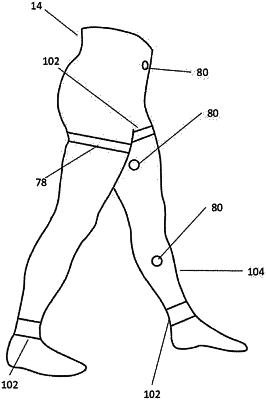| CPC A41D 13/1281 (2013.01) [A41D 13/1254 (2013.01); A41D 17/02 (2013.01); A61B 5/0535 (2013.01); A61B 5/1116 (2013.01); A61B 5/6804 (2013.01); A61B 5/7264 (2013.01); A41D 2400/38 (2013.01)] | 7 Claims |

|
1. A system for detection of a human disease, wherein the system comprises:
a compression garment, the compression garment comprising a wearable sensor network and an application;
the wearable sensor network comprising a plurality of electrodes,
wherein four electrodes of the plurality of electrodes are configured to be alternately and ipsilaterally activated in each leg of a user,
wherein the four electrodes are configured to be activated in a configuration consisting of two current-injecting electrodes and two voltage-sensing electrodes;
and the wearable sensor network comprising a multiplexor configured to sequentially alternate which two electrodes of the four electrodes are activated as the voltage-sensing electrodes, enabling a data collection and a data analysis from a plurality of different locations of each leg of the user,
the collected data comprising ipsilateral bio-impedance measurements of each location of the plurality of different locations of each leg of the user, and each location of the plurality of different locations of each leg of the user positioned between the two voltage-sensing electrodes;
wherein the wearable sensor network further comprises a central hardware unit,
wherein at least one accelerometer-gyroscope module and at least one bio-impedance module are connected to the central hardware unit by wiring, textile electronic traces, or conductive connections;
the at least one bio-impedance module configured to collect the ipsilateral bio-impedance measurements from each location of the plurality of different locations of each leg of the user positioned between the two voltage-sensing electrodes,
and the at least one accelerometer-gyroscope module configured to collect an additional data set from the user,
the additional data set comprising acceleration and gyroscopic data from each leg of the user;
wherein the central hardware unit is configured to
supply power to the at least one accelerometer-gyroscope module and to the at least one bio-impedance module;
to temporarily store the ipsilateral bio-impedance measurements from the bio-impedance module and the additional data set from the at least one accelerometer-gyroscope module;
and to transmit the ipsilateral bio-impedance measurements and the additional data set to a mobile application,
wherein the mobile application is configured to receive a third data set from additional modules and to further transmit the ipsilateral bio-impedance measurements, the additional data set, and the third data set to an online server;
wherein the bio-impedance module is configured to collect the ipsilateral bio-impedance measurements by delivering a plurality of current signals to each location positioned between the two voltage-sensing electrodes of each leg of the user,
the plurality of current signals having varying current magnitudes of up to 5 mA every 1 kHz across 5 kHz to 100 kHz;
and is further configured to analyze the plurality of delivered current signals after the plurality of delivered current signals have passed through a section of tissue at each location positioned between the two voltage-sensing electrodes of each leg of the user.
|